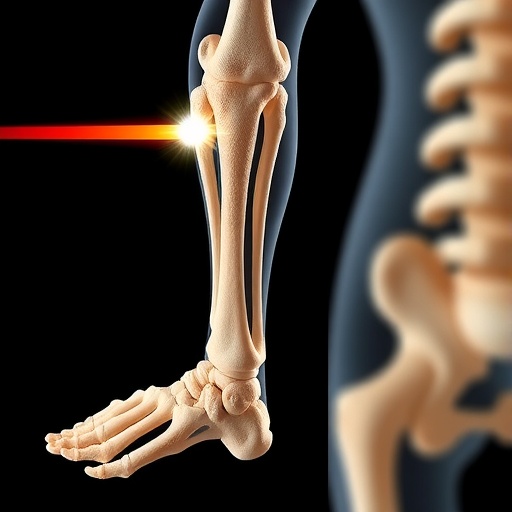In an intriguing development at the crossroads of forensic science and materials engineering, recent research has shed new light on the interaction between high-velocity projectiles and human bone. This cutting-edge study meticulously compares the extent and nature of projectile deformation when bullets impact human bone tissue versus a widely used synthetic surrogate, polyurethane. The investigation offers groundbreaking insights that could profoundly influence both forensic investigations and ballistic testing protocols.
For decades, forensic experts have grappled with the challenges of accurately reconstructing shooting incidents from skeletal remains. Traditional approaches often relied heavily on assumptions drawn from tests conducted with synthetic materials that simulate human tissue. Polyurethane, in particular, has been a favored simulant due to its ease of use and reproducible mechanical properties. However, until now, a comprehensive comparison detailing how projectiles deform upon striking these different materials was lacking.
The study meticulously examined various projectiles subjected to ballistic testing against human bone samples and polyurethane blocks designed to mimic bone density and structural properties. Using advanced imaging techniques and detailed morphological analysis, researchers observed substantial differences in the way projectiles behaved upon impact. Notably, the deformation patterns revealed a significant disparity in energy transfer dynamics between actual bone and the synthetic simulant.
Human bone, characterized by its complex organic matrix combined with mineralized components, demonstrated a unique response to projectile impact. The projectiles striking bone showed varied deformation contingent on factors like microstructural orientation and bone density variation. This heterogeneity led to irregular projectile shapes post-impact, challenging previous assumptions that projectiles undergo uniform deformation in bone-like materials.
Conversely, the polyurethane simulant exhibited a more consistent and predictable deformation pattern. Due to its homogenous nature at the microscopic level, bullets tended to deform symmetrically upon impact within this medium. This stark contrast underscores the limitations of polyurethane as a standalone proxy for real bone in forensic ballistic analyses. The generalized deformation observed in polyurethane lacks the nuanced signatures that actual bone imparts to projectiles during gunshot events.
A particularly striking finding involves the implication of projectile deformation patterns for forensic reconstruction. Since the physical alterations in projectiles can provide clues about the nature of the target material, weapons used, and the shooting conditions, the nuances captured from bone interactions carry invaluable information. The study’s revelations suggest that many forensic cases building on polyurethane-based experimental data might need re-evaluation with consideration of real bone dynamics.
Furthermore, the research utilized high-resolution 3D scanning and micro-computed tomography to visualize the microstructural changes within projectiles. This allowed the team to map the intricate fracture surfaces, peeling layers, and compressive zones within the bullets after passing through bone tissue. The complexity unveiled in these damages indicates that bone’s composite material properties significantly influence projectile integrity, a consideration largely underestimated previously.
The implications extend beyond forensic science into the realm of ballistic trauma medicine. Understanding the precise deformation and fragmentation behavior of projectiles within bone can enhance the diagnosis and treatment of gunshot injuries. Customized treatment plans could emerge from these insights, improving surgical interventions and prognosis for patients suffering from ballistic trauma.
Moreover, this comparative study advocates for the re-assessment of synthetic simulants currently in use for ballistic testing and weapon certification. The authors suggest that future materials need to replicate not just the gross mechanical properties of bone but also its hierarchical structural complexity to provide more accurate deformation patterns. This would bridge the gap between laboratory ballistics and real-world forensic scenarios, yielding data that genuinely reflect human tissue interactions.
The methodology implemented in this research sets a new standard for forensic ballistic experimentation. By pairing biological specimens with advanced synthetic analogs and employing state-of-the-art imaging modalities, the investigators established a novel framework for comprehensive projectile-bone interaction analysis. Their approach encourages multidisciplinary collaboration among forensic pathologists, materials scientists, and ballistic engineers.
Interestingly, the study also delves into the potential for adapting polyurethane formulations to better simulate bone properties. It explores modifications involving composite fillers and structural reinforcements aimed at mimicking bone’s anisotropic nature. These adaptations could eventually produce simulants that produce projectile deformations closely matching those seen in human bone impacts, enabling more reliable forensic validations.
This research marks an important milestone in forensic methodology, pushing forward the precision of ballistic evidence interpretation. With stricter judicial scrutiny of forensic testimony worldwide, such advancements offer critical improvements in evidence credibility, potentially influencing legal outcomes and justice administration.
In conclusion, the comprehensive exploration of projectile deformation presented in this groundbreaking study opens exciting new avenues in forensic science. Its findings underscore the essential need for realistic target materials reflecting true bone characteristics in ballistic testing to ensure accuracy in forensic reconstructions and clinical applications. The future of forensic ballistics looks set to benefit immensely from these insights, promising enhanced accuracy in unraveling the mysteries behind gunshot wounds.
By fundamentally redefining our understanding of projectile-material interactions through rigorous experimentation, this work stands as a testament to the power of interdisciplinary research in solving complex forensic puzzles. As forensic experts and material scientists continue to collaborate, the scene is set for revolutionary improvements in ballistic evidence analysis, bridging the gap between laboratory simulations and real-world human injury trauma.
Subject of Research: Projectile deformation upon impact with human bone compared to polyurethane simulant.
Article Title: Projectile deformation on human bone and on a polyurethane simulant.
Article References:
Kerkhoff, W., Mattijssen, E.J.A.T., van Rijn, R.R. et al. Projectile deformation on human bone and on a polyurethane simulant. Int J Legal Med (2025). https://doi.org/10.1007/s00414-025-03650-8
Image Credits: AI Generated




